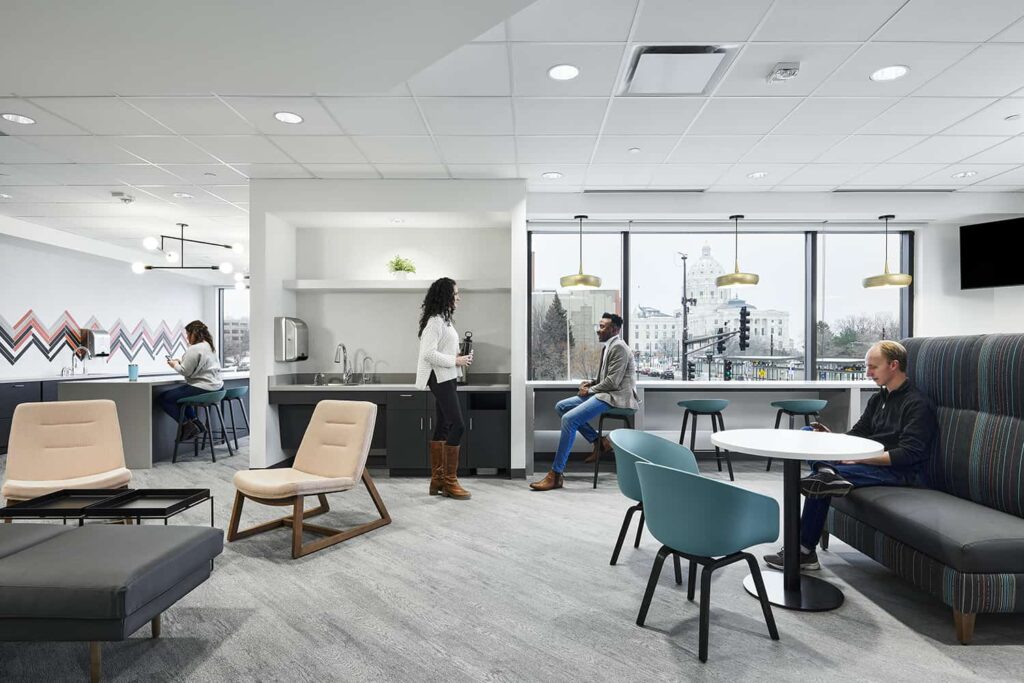During part two of my conversation with Jennifer Stukenberg, NCIDQ, LEED AP, WELL AP, she shared more about what to expect with the hybrid work model. But first, she imparted some insights on how the remote environment has helped employees and businesses thrive in some areas while other aspects of traditional work have taken a hit.
There’s No Place Like Work from Home?
In the early stages of the pandemic, Stukenberg was surprised to see that productivity and wellbeing scored relatively high in workplace studies, and have remained fairly high ever since. However, she also observed a drop in engagement, with indications of workers feeling disconnected from their coworkers and company culture. Learning and skills development activities also significantly decreased, further pinpointing the value workers get out of physically going into the office.
While many companies have already modified their training programs, with a particular emphasis on transforming their onboarding strategies, it’s difficult to account for the loss of the informal learning that happens when workers are in proximity to one another. With the BWBR internship program, for example, the team compensated for this lack of in-person interaction with Zoom sessions aimed at recreating the effect of working side by side with more senior staff. Besides creating closer connections, this approach came with the added benefit of accessing a talent pool from anywhere in the country, rather than being geographically limited.
Putting People First
Continuing to take the people-first approach spurred on by the pandemic will be key in the newly tightened labor market. Many organizations put a huge emphasis on flexibility, empathy, and well-being, and took great care to communicate and stay connected with their people during the pandemic. In return, employees did more than their part to stay productive and keep the business functioning, and now expect that people-first approach to continue indefinitely.
A one-size-fits-all strategy is especially ill-suited for those hit particularly hard by the past year, including younger workers and families, yet companies can’t afford to miss out on those talent pools. A flexible, hybrid work model that lets employees choose how and when they work has become a powerful and popular option, and Stukenberg suggests that companies should start moving in that direction now if they haven’t already.
Flexible Workspaces, Flexible Schedules
After contending with many distractions over the last year of working from home, employees also want more control over their environments, especially factors like environmental stimulation and ergonomics. “I like a little bit of busy-ness around me on certain days when I’m feeling drained,” said Stukenberg. “[And] I think a lot of people miss their nice sit-to-stand desks and their good chairs. Even temperature and lighting–I like the fact that my office isn’t freezing at home!” Employers will likely need to offer a range of work settings with more individual controls, plus access to varied spaces such as private focus rooms and areas for collaboration. The classic sea of cubes may become a rarity now that workers know better than ever what they need to succeed.
And the office schedule of the near future? The power of routine is that it lets people focus on the work, but the old 9-5 routine went out the window while workers were in survival mode. One result of the pandemic may be a greater sense of consideration for others–flex environments will require advance planning in lieu of the casual desk drop-in of the past. The new etiquette may be to send an instant message before popping by your colleague’s workspace to make sure they’re in the office and that you can find where they’re sitting in an unassigned seating plan.
Emphasis on Equity and Diversity
An important consideration (and potential benefit) of a hybrid work is that it forces a greater emphasis on equity and inclusiveness, since companies must adapt to ensure team members can all equally share ideas and participate in project work regardless of location. Tools like Miro and Microsoft Teams can help teams collaborate without being in the same room, and creating company guidelines around hybrid in-person/ virtual meetings can help create a more consistent, accessible experience for everyone.
As Stukenberg puts it, “We all want equity and diversity because it’s the right thing to do, but also because it makes us all better. A diversity of ideas has been proven over and over again to be the key to success.” Pursuing equity can’t be just a passive thing—it requires commitment and action in order to impact employees’ experiences. “Everyone can see when you’re being inclusive, and they feel that as part of your culture.”
The Future is Flexible
One recent study by Leesman of more than 840,000 employees revealed that 83% said their home enabled them to work effectively, compared to just 64% who said the office enabled them to work effectively. If companies want workers to come back in-person while retaining the productivity gains realized while working from home, thoughtful changes to office spaces may be in order. Companies will also likely see a benefit from offering employees the choice to work from home while still encouraging them to use the office for in-person collaboration. Finding that balance will help bridge the gap between employee expectations and the environments that best support their work.
“I know offices that are made for work are not working the way [companies] want [them] to … if you don’t have good office space that supports the tasks that people need to do now, then people won’t want to come to the environment because their home offices will likely be performing better for them. So companies are going to have to make some modifications in order to adjust to this evolving way we work.”
Jennifer Stukenberg, NCIDQ, LEED AP, WELL AP








